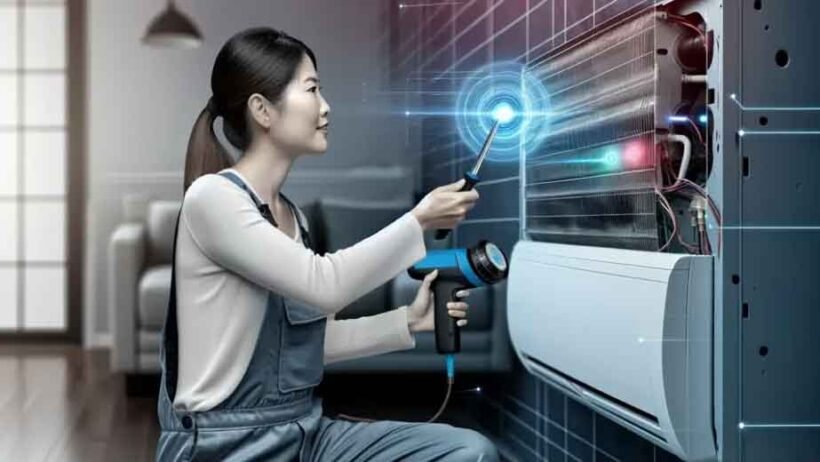Air conditioning systems have become an essential part of maintaining comfort in homes and workplaces, especially in regions where temperatures fluctuate widely. With the rapid advancements in smart technology, the way AC repair is approached has significantly changed. Modern tools and connected devices are allowing technicians to diagnose, monitor, and resolve issues more efficiently than ever before, a point highlighted by the Atara Property Management team. For homeowners, this means better performance, energy savings, and fewer unexpected breakdowns. We will explore how smart technology is reshaping the field of AC repair and why it has become such a vital component of maintaining climate control in today’s world.
How Smart Technology Transforms AC Repair
- Remote Diagnostics and Monitoring
One of the most valuable contributions of smart technology to AC repair is the ability to diagnose problems remotely. With connected sensors and smart thermostats, technicians no longer need to rely solely on in-person inspections to identify issues. These systems can detect irregularities in energy consumption, unusual temperature fluctuations, and compressor performance. The data is then transmitted to service providers who can analyze it in real time. This means potential issues can be flagged before they escalate into major breakdowns.
For homeowners, this translates into fewer emergency calls, faster service, and cost savings. Remote diagnostics also allow repair professionals to arrive prepared with the right tools and parts, eliminating unnecessary delays. The combination of real-time monitoring and predictive alerts ensures that small problems, like clogged filters or refrigerant imbalances, are corrected before they evolve into costly repairs. To see how these advancements can make a difference in everyday comfort, simply click here for more details.
- Enhanced Energy Efficiency Through Smart Sensors
Another crucial advantage of smart technology in AC repair is its contribution to energy efficiency. Traditional systems often operate on fixed schedules or manual adjustments, potentially resulting in unnecessary strain and higher energy costs. Smart sensors embedded within modern units can automatically adjust cooling cycles based on occupancy, outdoor conditions, and humidity levels. When these sensors detect inefficiencies or irregularities, they can notify both the homeowner and the repair technician. This allows for proactive adjustments that keep energy use balanced and prevent long-term wear on the system.
For instance, if sensors identify a motor working harder than usual, it could indicate buildup or mechanical resistance that needs immediate attention. Addressing such issues promptly not only prevents larger repairs but also keeps monthly energy bills in check. The integration of these intelligent sensors makes AC units more reliable while significantly reducing the environmental impact of cooling.
- Smart Thermostats and User Control
The rise of smart thermostats has revolutionized how homeowners interact with their air conditioning systems. Beyond offering convenience, these devices play an important role in identifying repair needs. Smart thermostats can track temperature patterns, report inconsistencies, and highlight areas where the system struggles to maintain desired settings. For instance, if one area of the home consistently feels warmer despite thermostat adjustments, it could indicate duct blockages, refrigerant issues, or failing components. By analyzing this data, technicians can better understand the root cause of problems before making physical inspections.
Moreover, smart thermostats empower homeowners to detect early warning signs without technical knowledge, bridging the gap between daily use and professional repair. This partnership between homeowner awareness and technician expertise leads to more efficient maintenance. Additionally, remote access features allow both parties to monitor the system from anywhere, ensuring comfort and reliability even when occupants are away from home.
- Predictive Maintenance with Artificial Intelligence
Artificial intelligence has entered the AC repair industry with powerful predictive capabilities. Instead of reacting to failures, AI-driven systems can forecast them. By processing large amounts of performance data, AI can identify patterns that indicate declining efficiency or potential breakdowns. For example, slight changes in airflow, vibration, or compressor cycles may not be noticeable to the homeowner but can signal impending issues to an AI system. This predictive maintenance approach allows technicians to schedule repairs at convenient times, avoiding costly emergencies during peak seasons.
Homeowners benefit by extending the life of their units, improving performance, and ensuring comfort without unexpected interruptions. The use of AI also reduces unnecessary part replacements, as repairs are guided by accurate predictions rather than assumptions. Ultimately, predictive maintenance supported by AI saves time, lowers costs, and provides peace of mind by keeping systems in top condition with minimal disruption.
- Integration with Smart Homes and IoT
The growing trend of smart homes has brought new opportunities for AC repair. When integrated with the Internet of Things (IoT), air conditioning systems become part of a larger network of connected devices. This integration allows for seamless communication between appliances, sensors, and even weather forecasts. For instance, if an upcoming heatwave is predicted, the system can adjust in advance to handle the increased demand without overloading components. When issues arise, IoT connectivity ensures that alerts are immediately sent to both the homeowner and service provider, minimizing downtime.
Repair technicians can access detailed diagnostic reports before even setting foot on the property, making the repair process faster and more accurate. Additionally, IoT integration allows for centralized control, so maintenance schedules, performance tracking, and repair history can all be managed from one platform. This interconnected approach ensures that AC systems remain efficient, responsive, and well-maintained within a broader smart ecosystem.
Smart technology has dramatically reshaped the landscape of modern AC repair, making it more efficient, proactive, and reliable. From remote diagnostics and predictive maintenance to IoT integration and enhanced technician tools, these innovations have redefined what it means to maintain comfort in homes and businesses. For homeowners, the benefits are clear: fewer unexpected breakdowns, longer system lifespans, and greater control over indoor comfort. For technicians, smart technology provides powerful tools to deliver precise, data-driven solutions. As air conditioning systems continue to evolve alongside digital innovation, the future of AC repair will remain focused on blending technology with performance, ensuring that cooling solutions are not only reliable but also aligned with the demands of modern living.








